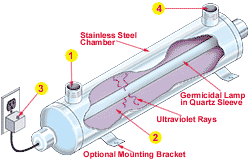Ultraviolet Light Disinfection For Drinking Water
ByUsing Ultraviolet (UV) Light for drinking water disinfection dates back to 1916 in the USA. The National Drinking Water Clearinghouse states that Ultraviolet light offers no residual disinfection in the water passing through the unit and the water is available for immediate usage.
What is UV Disinfection?
UV light, which continues to be a reliable means of disinfection, involves exposing contaminated water to radiation from UV light. The treatment works because UV light penetrates an organism’s cell walls and disrupts the cell’s genetic material making reproduction impossible. A special lamp generates the radiation that creates UV light by striking an electric arc through low-pressure mercury vapor. This lamp emits a broad spectrum of radiation with intense peaks of UV wavelengths of 253.7 nanometers.
Advantages
Generally, an Ultraviolet light is simple to install and requires little maintenance or space. Improved safety, minimum service time, low operation and maintenance costs and the absence of a chemical smell or taste in the finished water are primary factors for selecting UV technology rather than traditional disinfection technologies.
UV breaks down or removes organic contaminants. UV light disinfection does not form any disinfection by-products nor does it cause any increase in assimilable organic carbon (AOC). Government research has confirmed that UV effectiveness is insensitive to temperature and ph differences. In addition, researchers found that UV application does not convert nitrates to nitrites, or bromide to bromines or bromates.
The advantages of using UV rather than chemical disinfection include;
^ Has no known toxic or nontoxic by-products
* Has no danger of overdose
* Removes organic contaminants
* Has no volatile organic compound (VOC) emissions or toxic air emissions
* Has no on-site smell and no smell in the final water product
* Requires very little contact time (seconds verse minutes for chemical disinfection)
* Does not require storage of hazardous material
* Requires minimal space for equipment and contact chamber
* Improves the taste of water because of some organic contaminant and nuisance microorganisms are destroyed
* Does not affect minerals in the water
* Has little or no impact on the environment
Diagram of an Ultraviolet System
 |
1. | Incoming water enters the UV unit and flows into the space between the quartz sleeve and the outside chamber wall. |
| 2. | Within the chamber, water is exposed to intense germicidal ultraviolet radiation. | |
| 3. | Transformer with LED indicator light provides visual indication of germicidal lamp operation. | |
| 4. | Water leaving the UV unit is disinfection free and instantly ready for use. |




